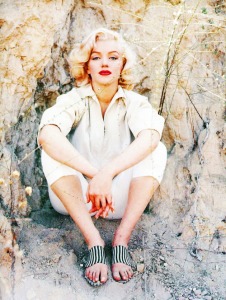“My body turned everything on…and there was rarely anything human about it.”
– Marilyn Monroe
Who was she? Probably the biggest iconized sex symbol in America; and yet, Monroe’s entire demise was based on the fact that the world refused to see her as anything otherwise. It is a sad illusion of fantasy and fame. It is a complete lie told by generations before us—that women are not who they are without the posturing of their bodies. It is the push behind money hungry, sex driven industries like pornography, human trafficking, music and television. The systematic sexualization of the female body has impressed upon our society the idea that women’s identities are relegated to how their bodies look, perform, and appease men through servitude and passivity. Even today, women are expected to relinquish any right to autonomous thought and singularity. It’s almost oxymoronic since so much of what we see in the media also suggests that women be educated and financially independent. Wow, isn’t that interesting? To say the least, patriarchal norms have, over time, provided the platform, through several media outlets, for the oversexualization of women—resulting in the dehumanization of the female body. How do we begin to unpack this normalized convention that forces women to either completely desexualize herself; or sexualize herself under the guise that she’s strategically capitalizing off of “sex sells”? How do we begin to understand the very complex institution that makes navigating female sexuality a difficult (and daunting) task for both young girls and women?
One television show that comes to mind when I think about the posturing of female sexuality is Love and Hip Hop—all of the series’ seasons. All of the women, including the show’s founder and CEO Mona Scott-Young, present themselves as women in charge of their own franchise. They are baby-doll made up, tall in their stilt-like heels, and flamboyantly dressed in glimmer and lace. Every reference made to money is almost entirely linked to male sexual fantasies and desires of the female body. In fact, Love and Hip Hop’s newest cast member, Jessica Dime, made her first impression by dancing in complete nudity in one of Atlanta’s premier strip clubs: “Yeah that was me on the stage, butt ass naked, making this money!” It’s not surprising since strip culture has been on the up-rise since twerking went viral. Plus, exotic dancing is nothing new to society in general. But what do we do when sexualized female bodies are the only representation of women we see? Ms. Dime, like every woman, is entitled to present herself in any way she chooses. And make no mistake, I am not making the argument that her career choice is inferior, nor am I trying to convince women to deny their interpretation of sexuality and industry. I am, however, bringing attention to the ways in which we are being socialized to commodify our bodies in ways that teeter more towards exploitation than female independence.
Of course female sexuality has been on the radar since the beginning of time. Both historical and fictional narratives have situated the woman as a commodity. When I think of modern day sexual exploitation, I think of one of history’s most talked about female bodies, that of Saartjie "Sarah" Baartman—better known as “Hottentot Venus”. She was a South African woman who was sold and exhibited throughout Europe during the 19th century. She was poked and prodded, and deemed an exotic freak due to her large buttocks and breasts. Like many African women captured and sold into slavery (or, in this case, another form of slavery), she was subjected to the fantasies and obsessions of men who saw her only as a sexual beast. I’m sure she knew the thoughts they had—that they only recognized her body as a representation of her sexual prowess. Sarah knew that she would possess no autonomy due to this sinister form of presentation. I’m sure no one asked her what she thought either, since African women were almost always completely sexualized.
So, we fast forward to today when women are taught to attach so much of their identities to their sexuality. It is packaged and sold like a product in a store. I would suggest that the dehumanization of women has become even more pervasive because of different media outlets and shows likened to Love and Hip Hop. Admittedly, it can be confusing since we have influential artists like Beyoncé touting feminism, but then almost failing to show young girls and women that they are more than what their bodies can offer. Even recently, Beyoncé’s “big news” was that she keeps her body fit and trim by adhering to a vegan lifestyle. Really!? Again, this reinforces the idea that female identity is relegated to the body and has little to do with her emotions, intelligence and true desire.
Many of us do not understand the consequences of situating the body as the whole self. I once had a conversation with a close friend who was sexually abused while growing up, and she told me: “If I had internalized everything those people did to my body, I would have died. That’s when I learned that we are not our bodies.” It was one of the most profound messages I heard, and it stuck with me ever since. And knowing this; the icon Marilyn Monroe is known as one of America’s most prolific sex symbols. We herald her as a classic beauty—as many celebrities, black and white, have tried to emulate her sexuality. However, it is documented in both text and visual media that Monroe spent much of her life trying to escape the identity her sexuality created. She wanted to be understood and her craft taken seriously. She even hired famous photographer Milton Greene to capture her more nuanced self. And yet, society chooses only to define her in terms of her body. Now, isn’t that ironic?

